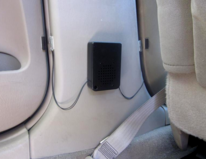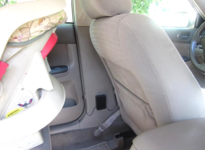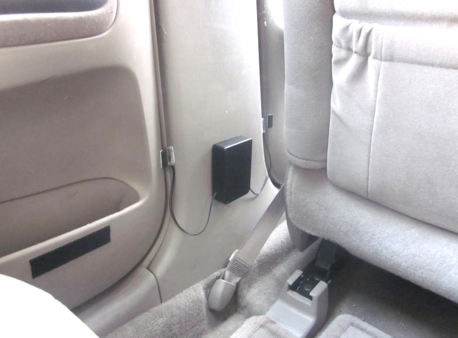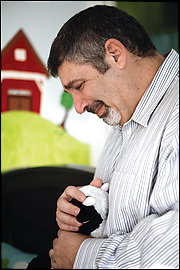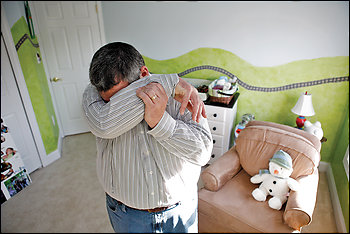The Baby & Children's industry has come up with all kinds of innovative and effective products for parents to babysafe their home. But in one aspect of keeping their customer's children safe, it has failed to step up to the plate. Every year, every summer without fail somewhere between 10 and 17 children in the US will be forgotten still strapped into their carseat in the back of the car, and die. And yet so far, no company has come up with a low cost, effective way to prevent this.
This should not be - and it needn't be anymore.
I believe I have come up with one half of a solution to this problem. But I am just a lone inventor and can't do it all alone. I will be exhibiting at the ABC Show hoping to meet a company or backers willing to step up to the plate and work with me to get this in the hands - and cars - of parents.
I especially hope that the manufacturers of car seats will take advantage of this opportunity and consider what an impact putting one in the box of every car seat they ship out would have on stopping these needless deaths.
Sincerely,
Joe Dorsey
HOW DOES IT WORK?
The demo videos have full details but in a nutshell,
Using magnetic reed sensors – the same thing you put on your doors and windows if you have a home security system – the alarm senses the opening of one of either of the back doors and also the driver’s door. Whenever the parents opens up the back door to put their child in, it senses that and it becomes armed and active, sounding a double “ping” confirmation tone to assure them the system is on. Subsequently when they open up their own driver's door to get in, it senses that too and plays a medium volume, 4 second music box chime to confirm once again the system is on and working. At this point the parent and child are now in a kind of security envelope. The parent can not exit the vehicle without this chime being triggered again and hearing the reminder chime. It is only when they go back and open up the back door to take the child out does the alarm turn itself off, automatically going into sleep mode till the next time. When it does so, a voice message states, "The alarm in now off".
WON'T THE PARENT BECOME USED TO THE SOUND?
Possibly, but our brains are trained by repetition and that is a good thing. Every time the parents hears the Backseat Baby Alarm's unique music box melody, it will only be when they are with the baby - no other times -and that constant reinforcement of "music box sound" = "baby is with me" will probably work powerfully to give the brain a little jolt should there be a day when it needs a little back up.
HOW ABOUT INSTALLATION, BATTERIES, ETC?
The device is stand alone. Installation is basically “peel & stick”. It works with any type of vehicle and uses 3 replaceable AA batteries. Also, note that you can monitor either the drive side door immediately behind you or the passenger side door as the lead wires for the rear door have been lengthened to 8 ft. long. If you prefer to have your car seat on the passenger side and monitor that door, you simply lay the wire under the carpet mats and at the hump, tuck it in under the rear edge of the center console so its out of harm' s way. (I have a Toyota Camry and it was very easy to do, just used a kind of "flossing" motion).
IF THE PARENT USES BOTH DOORS TO GET THE CHILD IN & OUT, CAN IT MONITOR BOTH ?
In a fashion, yes. The answer is simply to install 2 units, one for each back door. The only rule would be that you must use the same door to get the child out as you did when you first put them in. In the future will probably have a version that can monitor 2 doors at once but to keep costs down for everyone at this beginning stage I am just suggesting you use two to achieve the same function.
PRICING?
Because it uses technology that has been around for years, it is very reliable and moreover, low cost to produce. Though not set in stone, I am looking at a wholesale price of around $14/unit but that is just a preliminary goal. It is liable to change but I think by the time the show opens I will have all my costs in and be able to give a hard quote.
TESTING?
I am endeavoring now to do a "soft launch" with the aim of of conducting a large scale field test with around 250 parents. I know it works as designed but of course there is always the unexpected when something new is used in real life conditions. .
ABOUT ME
I live in Fort Mitchell, Ky just a few minutes outside of downtown Cincinnati with my two younger children of three. I am 51 years old. I grew up here then after college ended up living overseas for about 15 years mainly working in Japan. I came back to the US in 1996 and since them I have made a living as a real estate agent for Remax. I just mention these things in case you don't know me personally and want to verify I am real.
Needless to say I'm not some engineer or electronics expert. I guess I am what you call a "dining room table" inventor. But maybe that was a blessing in disguise. It forced me to come up with something that solved the problem design using cheap, off the shelf stuff I could buy at Home Depot and my local hobby shop making up for it with innovative design rather than over-engineering it and ending up with something that was just too expensive for the average parent as consumer to consider. Case in point is First Year's IAlert Car Seat. Their system calls your smart phone if you forget your child. The chair without the system is $170. With it is a mere $350. Hopefully you don't miss the call.
I was inspired to start working on my invention by my falling apart old car. The spring that retracted the driver's seat belt was broken so nearly every time I got out it dangled out the door and I ended up clanging my door on it and the door would not close. One night after coming home and it happened again for the umpteenth time, I thought to myself, "geez, I wouldn't mind it so much if it had some useful purpose" and for whatever reason the idea of something that would stop parents from closing their door until they got their child out of the back of the car popped into my head. Why? I don't know, it just did. It wasn't even hot - it was October.
That was about 3 years ago. Since then I have spent hours and hours sitting at my dining room table gluing, cutting, and building all kinds of different prototypes, studying patents, reading about these cases and the circumstances surrounding them to understand them, and sitting in my car checking and testing. I am sure my neighbors are suspicious of what the heck I am doing in my car all the time. Oh well. I made my first prototypes using the sound modules I got out of recordable talking greeting cards from Krogers. But finally it all came together this year with the help of my 90 year old father who is an electrical engineer and his cronies and I have what I believe is a very viable, affordable, and effective product.
Moreover, I believe it's a product that is going to make a difference.
"Forgotten Child" - The Real Numbers
The media often cite numbers about this phenomena from Professor Jan Null, professor at USF and his website ggweather.com/heat but often in a somewhat misleading way.His data includes child vehicular hypothermia deaths of all types including ones other than from “forgetting” such as “climb ins”, “trunk entrapment”, “knowingly left”, and "miscommunication between parents". The numbers are quoted without explaining this and giving a false impression that all child vehicular hypothermia deaths are attributable to a parent or caregiver forgetting. His data though fortunately includes the date, place, and original newspaper source article for each incident. By examining every article for the last five year and where necessary doing further research, I was able to ascertain which of the total were truly deaths due to “forgetting”.Here then are what I think are the most accurate numbers available:
2008 - 18
2009 - 12
2010 - 17
2011 - 9
2012 - 15
2013 - 15 as of 9/11
More interstingly, I also looked into the circumstances as far as whether the parent or caregiver forgot the child in the driveway of their own home, on the way to work or work related, or in a shopping center. Here is what I found:
Work Home Shopping Not Clear
2008 8 10









2009 9 3
2010 8 8 1
2011 6 3
2012 10 3 1 1
--
Total: 41 27 1 2
As you can see not surprisingly 2/3rd's of the "distraction location" as I refer to it was work. In the typical case, the parent/caregiver simply loses mental awareness of the child somewhere along the route, the child falls asleep, and the parent/driver leaves them in the parking lot at their job or place of business.
The other approximate 1/3 was the parent/caregiver not bringing the child in after pulling into the driveway. (These even I have a hard time believing but it probably had heavily to do with physical or mental exhaustion as well as distraction)
Surprisingly enough and contrary to popular image, I only found one case where the child was left and died in a shopping center parking lot. Although pure conjecture on my part, the number left might be actually higher but fortunately they never made the news as a passersby saw or heard the child and either called police or notified store management.
Also not included are cases wherein the child was found and rescued and this is reported. However, what is not reported later on as it is not immediately obvious at the time of the incident is that the child was in the car so long that brain damage resulted. There are a number of such equally tragic cases.
ABOUT THE PHOTOGRAPHS
There are two photos I came across when looking into this phenomena that I still have a hard time looking at and am using here with permission. They are of Miles Harrison. He forgot to drop his 21 month old son off at day care on the morning of July 8, 2008. He was put on trial but acquitted. Gene Weingarten of the Washington Post interviewed and wrote extensively of Mr. Harrison's story as well as several other parents who had this tragedy befall them for his 2009 feature article, "Fatal Distraction" which later won a Pulitzer. This is how he described the trial,
"The room was a sepulcher. Witnesses spoke softly of events so painful that many lost their composure. When a hospital emergency room nurse described how the defendant had behaved after the police first brought him in, she wept. He was virtually catatonic, she remembered, his eyes shut tight, rocking back and forth, locked away in some unfathomable private torment. He would not speak at all for the longest time, not until the nurse sank down beside him and held his hand. It was only then that the patient began to open up, and what he said was that he didn't want any sedation, that he didn't deserve a respite from pain, that he wanted to feel it all, and then to die"
I believe these photos were taken during one of those interviews in the nursery of his deceased son Chase as they walked thru the home.
I don't believe I have ever seen a look of such pure regret and grief before. It would be bad enough losing your child, but to be the one responsible for that loss?
Unimaginable.
I hope if you are a member of one of the infant seat manufacturers I mentioned above you will come see my demo model in Booth IC 114 in the Inventor's Showcase at the ABC Expo in October. If you are member of the media, I hope you will consider spreading the word of what I am trying to do and about my campaign. No more fathers, no more mothers, no more families should have to experience this kind of heartbreak. It's time for these tragedies to end for good.
A much needed, production ready, low cost invention
to end the shocking phenomena of parents forgetting their child in the back seat of a hot car.
1st Booth on the left (IC114) in the Invention Connection Showcase!
Photos by Rebecca Drobis
